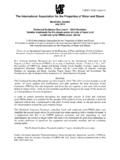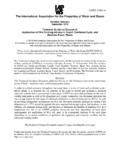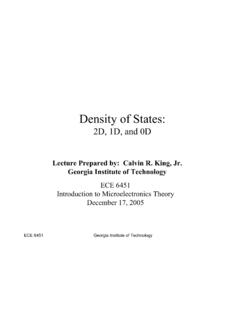Transcription of The International Association for the Properties of Water ...
1 The International Association for the Properties of Water and Steam Lucerne, Switzerland August 2007 Revised Release on the IAPWS Industrial Formulation 1997 for the Thermodynamic Properties of Water and Steam (The revision only relates to the extension of region 5 to 50 MPa) 2007 International Association for the Properties of Water and SteamPublication in whole or in part is allowed in all countries provided that attribution is given to the International Association for the Properties of Water and Steam President: J. R. Cooper School of Engineering and Materials Science Queen Mary, University of London Mile End Road London E1 4NS, England Executive Secretary: Dr. R. B. Dooley Structural Integrity Associates, Inc. 2616 Chelsea Drive Charlotte, NC 28209, USA email: This revised release replaces the corresponding release of 1997 and contains 49 pages, including this cover page. This release has been authorized by the International Association for the Properties of Water and Steam (IAPWS) at its meeting in Lucerne, Switzerland, 26-31 August, 2007, for issue by its Secretariat.
2 The members of IAPWS are: Argentina and Brazil, Britain and Ireland, Canada, the Czech Republic, Denmark, France, Germany, Greece, Italy, Japan, Russia, and the United States of America, and associate member Switzerland. The formulation provided in this release is recommended for industrial use, and is called "IAPWS Industrial Formulation 1997 for the Thermodynamic Properties of Water and Steam" abbreviated to "IAPWS Industrial Formulation 1997" (IAPWS-IF97). The IAPWS-IF97 replaces the previous Industrial formulation "The 1967 IFC Formulation for Industrial Use" (IFC-67) [1]. Further details about the formulation can be found in the article by W. Wagner et al. [2] and for the extended region 5 in [2a]. Additional supplementary backward equations have been adopted by IAPWS and are listed in [2b]. The material contained in this release is identical to that contained in the release on IAPWS-IF97, issued by IAPWS in September 1997, except for the basic equation for region 5.
3 The previous basic equation for this region was replaced by a new equation of the same structure. For temperatures between 1073 K and 2273 K, this equation extends the upper range of validity of IAPWS-IF97 in pressure from 10 MPa to 50 MPa. Except for the basic equation for region 5 of IAPWS-IF97, the property calculations are unchanged. In addition, minor editorial changes to this document, involving correction of typographical errors and updating of references, were made in the 2007 revision, and again in 2009 and 2010. In 2012, the description of the range of validity of the equation for the metastable vapor was clarified. IAPWS also has a formulation intended for general and scientific use [3]. Further information about this release and other releases issued by IAPWS can be obtained from the Executive Secretary of IAPWS or from IAPWS R7-97(2012) 2 Contents 1 Nomenclature 3 2 Structure of the Formulation 4 3 Reference Constants 5 4 Auxiliary Equation for the Boundary between Regions 2 and 3 5 5 Equations for Region 1 6
4 Basic Equation 6 Backward Equations 9 The Backward Equation T ( p,h ) 10 The Backward Equation T ( p,s ) 11 6 Equations for Region 2 12 Basic Equation 13 Supplementary Equation for the Metastable-Vapor Region 17 Backward Equations 20 The Backward Equations T( p,h ) for Subregions 2a, 2b, and 2c 22 The Backward Equations T( p,s ) for Subregions 2a, 2b, and 2c 25 7 Basic Equation for Region 3 29 8 Equations for Region 4 33 The Saturation-Pressure Equation (Basic Equation) 33 The Saturation-Temperature Equation (Backward Equation)
5 35 9 Basic Equation for Region 5 36 10 Consistency at Region Boundaries 40 Consistency at Boundaries between Single-Phase Regions 40 Consistency at the Saturation Line 41 11 Computing Time of IAPWS-IF97 in Relation to IFC-67 43 Computing-Time Investigations for Regions 1, 2, and 4 43 Computing-Time Investigations for Region 3 45 12 Estimates of Uncertainties 46 13 References 49 3 1 Nomenclature Thermodynamic quantities: Superscripts: cp Specific isobaric heat capacity o Ideal-gas part cv Specific isochoric heat capacity r Residual part f Specific Helmholtz free energy * Reducing quantity g Specific Gibbs free energy Saturated liquid state h Specific enthalpy Saturated vapor state M Molar mass p Pressure Subscripts.
6 R Specific gas constant Rm Molar gas constant c Critical point s Specific entropy max Maximum value T Absolute temperature a RMS Root-mean-square value u Specific internal energy s Saturation state v Specific volume t Triple point w Speed of sound tol Tolerance of a quantity x General quantity Transformed pressure, Eq. (29a) Root-mean-square deviation: Dimensionless Gibbs free energy, = g /(RT ) Reduced density, = / * Difference in any quantity Reduced enthalpy, = h / h* Reduced temperature, = T / T* Transformed temperature, Eq. (29b) Reduced pressure, = p / p* Mass density Reduced entropy, = s / s* Inverse reduced temperature, = T*/ T Dimensionless Helmholtz free energy, = f /(RT ) a Note: T denotes absolute temperature on the International Temperature Scale of 1990.
7 Where xn can be either absolute or percentage difference between the corresponding quantities x; N is the number of xn values (depending on the property, between 10 million and 100 million points are uniformly distributed over the respective range of validity). 2 RMS11()NnnxxN 42 Structure of the Formulation The IAPWS Industrial Formulation 1997 consists of a set of equations for different regions which cover the following range of validity: K T K p 100 MPa K T K p 50 MPa . Figure 1 shows the five regions into which the entire range of validity of IAPWS-IF97 is divided. The boundaries of the regions can be directly taken from Fig. 1 except for the boundary between regions 2 and 3; this boundary is defined by the so-called B23-equation given in Section 4.
8 Both regions 1 and 2 are individually covered by a fundamental equation for the specific Gibbs free energy g( p,T ), region 3 by a fundamental equation for the specific Helmholtz free energy f ( ,T ), where is the density, and the saturation curve by a saturation-pressure equation ps(T). The high-temperature region 5 is also covered by a g( p,T ) equation. These five equations, shown in rectangular boxes in Fig. 1, form the so-called basic equations. Fig. 1. Regions and equations of IAPWS-IF97. Regarding the main Properties specific volume v, specific enthalpy h, specific isobaric heat capacity cp, speed of sound w, and saturation pressure ps, the basic equations represent the corresponding values from the "IAPWS Formulation 1995 for the Thermodynamic Properties of Ordinary Water Substance for General and Scientific Use" [3] (hereafter abbreviated to IAPWS-95) to within the tolerances specified for the development of the corresponding equations; details of these requirements and their fulfillment are given in the comprehensive paper on IAPWS-IF97 [2].
9 The basic equations for regions 1 and 3 also yield reasonable values for the metastable states close to the stable regions. For region 2 there is a special 5equation for the metastable-vapor region. Along the region boundaries the corresponding basic equations are consistent with each other within specified tolerances; for details see Section 10. In addition to the basic equations, for regions 1, 2, and 4 so-called backward equations are provided in the forms of T ( p,h ) and T ( p,s ) for regions 1 and 2, and Ts ( p ) for region 4. These backward equations are numerically consistent with the corresponding basic equations and make the calculation of Properties as functions of p,h and of p,s for regions 1 and 2, and of p for region 4, extremely fast. In this way, Properties such as T ( p,h ), h ( p,s ), and h ( p ) can be calculated without any iteration from the backward equation alone or by combination with the corresponding basic equation, for example, h ( p,s ) via the relation h ( p,T ( p,s )).
10 As a consequence, the calculation of the industrially most important Properties is on average more than five times faster than the corresponding calculation with IFC-67; for details see Section 11. The estimates of uncertainty of the most relevant Properties calculated from the corresponding equations of IAPWS-IF97 are summarized in Section 12. 3 Reference Constants The specific gas constant of ordinary Water used for this formulation is R = 526 kJ kg K . (1) This value results from the recommended values of the molar gas constant [4], and the molar mass of ordinary Water [5, 6]. The values of the critical parameters Tc = K (2) pc = MPa (3) c = 322 kg m (4) are from the corresponding IAPWS release [7]. 4 Auxiliary Equation for the Boundary between Regions 2 and 3 The boundary between regions 2 and 3 (see Fig. 1) is defined by the following simple quadratic pressure-temperature relation, the B23-equation 212 3nn n (5) where = p/p* and = T / T* with p* = 1 MPa and T* = 1 K.










